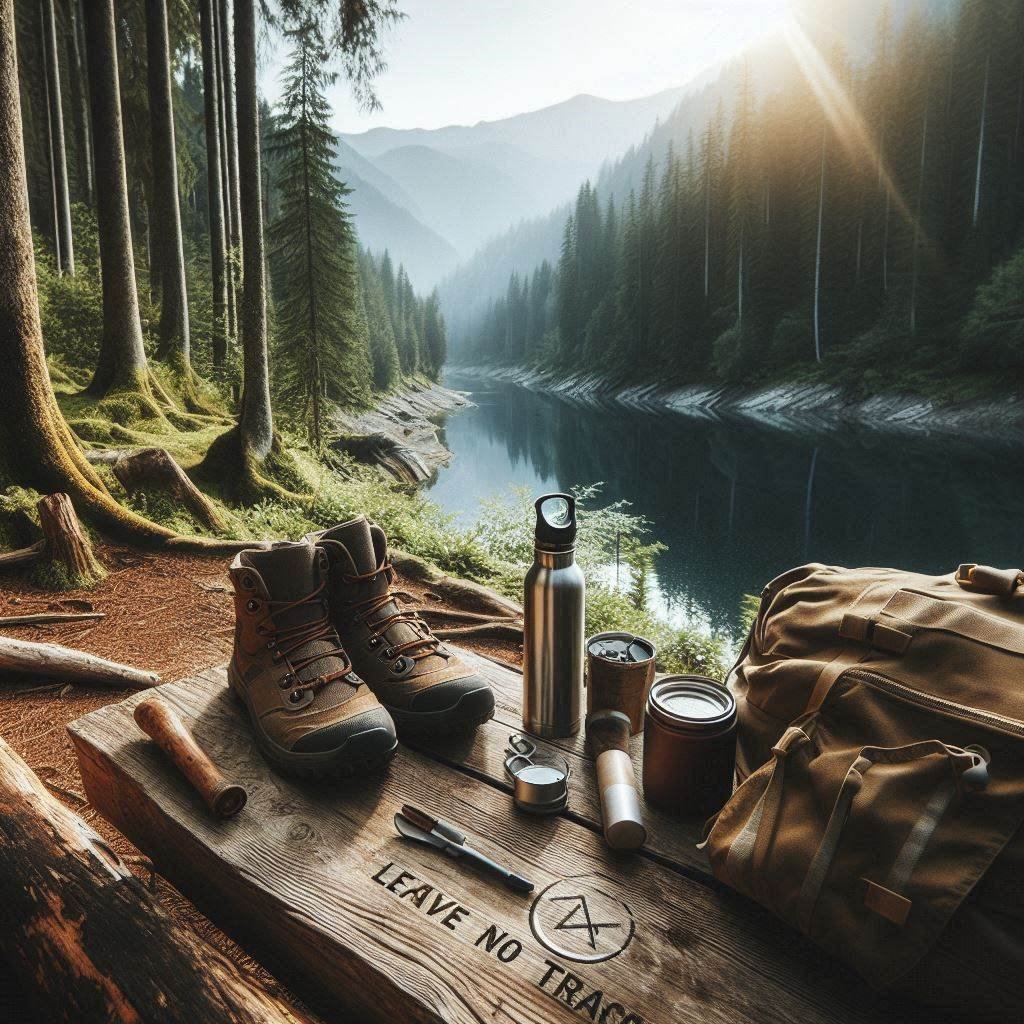Table of Contents
Tread Lightly: An Outdoor Enthusiast’s Guide to Leaving No Trace
For those of us drawn to nature’s wild spaces, the pull of the great outdoors is undeniable. The crisp mountain air, the hush of the forest, the boundless vistas that instill a sense of peace and wonder – these are the true revitalizers of the soul.
With the surge in outdoor recreation over recent years, however, comes a sobering reality: our adventures can take a heavy toll on the pristine environments we cherish.
Luckily, adopting sustainable practices through the Leave No Trace principles allows us to minimize our impact, ensuring these sacred spaces remain untarnished for future generations to enjoy.

The Seven Leave No Trace Principles
At the core of responsible recreation lies the Leave No Trace philosophy, encompassing seven key principles that serve as an ethical guiding light.
By understanding and applying these tenets, we can explore nature’s playgrounds while treading lightly and leaving no trace of our passage.
1. Plan Ahead and Prepare
A successful minimal-impact adventure starts well before hitting the trailhead. Researching the area’s rules, regulations, and route difficulty allows you to properly plan, prepare, and make sustainable choices along the way.
Pack the essentials – maps, adequate clothing for any weather, ample food and water – to avoid situations that could damage the landscape. And be sure to obtain any necessary permits or passes ahead of time.
2. Travel and Camp on Durable Surfaces
One of the primary goals of Leave No Trace is preventing further erosion and trampling damage to pristine areas. Stay on designated trails whenever possible, as cutting across trails creates unsightly detours and endangers delicate vegetation.
When camping, opt for established sites, areas of rock, sand, gravel or snow that can withstand repeated use. Avoid pitching tents on vegetation. Opt for smaller groups when possible, as larger groups amplify overall impact.
3. Dispose of Waste Properly
While it may seem obvious, the basics of proper waste disposal are often taken for granted. The simple rule is to pack out everything you pack in – and that includes all trash, food waste, and hygiene products.
Instead of toilet paper, use a pee cloth or make a cathole 6-8 inches deep at least 200 feet from water sources to bury solid human waste.
Even better, pack out human waste using portable camp toilets and WAG (Waste Alleviation and Gelling) bags. Doing so keeps trails clean and protects wildlife.
4. Leave What You Find
We’ve all been tempted to pocket a unique rock, wildflower, antler or piece of history as a souvenir. But removing objects, however small or seemingly insignificant, disrupts entire ecosystems.
It also robs others of discovering that same sense of wonder at an untouched find. To truly embrace Leave No Trace, we must respect and leave all natural objects and cultural artifacts as we find them.
5. Minimize Campfire Impacts
There’s no denying the primordial draw of an evening campfire, the dance of flames under a starry sky. But the impacts of fires on the landscape, from scorched terrain to air pollution and depleted wood sources, can no longer be ignored.
Use portable camp stoves powered by canister fuel instead whenever possible. If you do build a fire, do so only in established fire rings and use only dead and down wood found in the immediate vicinity – no cutting of trees or vegetation. Never leave fires unattended and ensure they are fully extinguished with water before departing.
6. Respect Wildlife
For the incredible diversity of animals inhabiting nature’s wild spaces, these are not playgrounds, but their homes, highways and food sources. We must commit to preserving intact habitats and leaving wildlife undisturbed.
Observe animals from a safe distance using telephoto lenses and binoculars. Never approach, call out to or feed wildlife, no matter how cute or habituated they appear.
Properly store all food and trash in airtight containers to avoid attracting animals to your campsite. Let wildlife be wild by giving them the space to remain so.
7. Be Considerate of Other Visitors
In keeping the spirit of leaving no trace, we must also consider the experience of fellow outdoor enthusiasts who’ve ventured into nature’s peace and solitude.
Yield to others on the trail, pass cautiously, and keep noise levels down out of courtesy. Give a wide berth to those camped at sites you encounter during your journeys, and choose campsites out of sight from trails and other visitors.
Respecting each other’s desire for tranquility is part of a true low-impact philosophy.

Eco-Friendly Gear for the LNT Adventurer
Upholding the tenets of Leave No Trace expands beyond simply altering behaviors to include sustainable gear choices as well. With a few key outdoor equipment swaps, you can elevate your adventures to a new level of environmental stewardship:
• Reusable Water Bottles and Hydration Reservoirs: Ubiquitous single-use plastic water bottles are an environmental blight producing colossal waste. Invest instead in a quality reusable bottle designed to withstand years of rugged use. Top insulated picks like Hydro Flask’s durable options keep beverages perfectly cold for up to 24 hours in scorching temps, while reservoirs connect seamlessly to backpacks for extended hydration on the move.
• Camp Stoves Fueled by Renewable Biofuel: While sipping a cold brew by the crackle of a campfire may rank among life’s simple pleasures, the environmental impacts of fires can no longer be ignored.
From noxious emissions to scarring of lands and depleted wood sources in high-use areas, we must seek cleaner alternatives.
Enter the new generation of compact camp stoves fueled by clean-burning, plant-based biolites rather than petroleum gas. Brands like MSR’s ultralight PocketRocket Stove are highly portable, efficient and leave zero trace on the landscape.
• Biodegradable Soaps and Wipes: Common soaps and shampoos with synthetic detergents can pollute waterways and harm aquatic life when used outdoors.
Swap them out for biodegradable, plant-based options designed to break down quickly after use. Popular biodegradable soaps include Dr. Bronner’s versatile line of body and dish cleaners, as well as Campsuds bundles with tiny towels that double as washcloths.
Build an Outdoor Ethics Skillset
While switching to eco-friendly gear is an important stride, building a true Leave No Trace ethic goes beyond physical gear to nurturing sustainable habits.
Practicing these key skills will help ingrain an environmental stewardship mindset:
• Mastering Environment-Friendly Hygiene: Rather than soap and water for washing up, use a “soap pot” to contain gray water runoff. Conserve water by giving up washcloth routines in favor of biodegradable hand wipes on short trips. For human waste, utilize a portable toilet system or dig a proper 6-8″ cathole then pack out your toilet paper.
• Navigation With Minimal Impact: Always carry a physical map and never rely solely on GPS apps that could fail or drain batteries when you need them most. Learn how to orient yourself and navigate cross-country to avoid trail-blazing or getting lost off-trail, which often leads to land erosion and trampling of vegetation.
• Campfood Beyond Single-Use Packaging: Ditch the waste generated by individual packaged items like energy bar wrappers and single-serve pouches. Repackage foods in reusable containers at home and cook meals from dehydrated ingredients or lightweight bulk items like grain, beans, fruit and nuts.
• Campsite Selection and Protection: Seek out established sites whenever possible, steering clear of pristine areas with no obvious human impacts. Once set up, designate specific areas for cooking, washing and tent pitching to contain your footprint. Use a ground cloth under tents and consider bringing a shovel to naturalize drainage areas before departing.
• Ethical Campfire Building: If fires are permitted, gather only dead and down wood no larger than an adult’s wrist from within the immediate area – never cut branches or strip bark off trees.
Use an existing fire ring if available, otherwise build a mound fire that can be fully extinguished, scattered and naturalized before breaking camp.
Whether for a weekend escape or an epic thru-hike, taking steps to minimize our impact allows us to protect the sacred places that rejuvenate body and soul.
As outdoor enthusiasts, we must embrace Leave No Trace not just as a convenience, but as an unwavering ethos to preserve these wild lands into perpetuity.
So lace up those boots, grab your reusable bottle and let’s tread lightly into nature’s boundless embrace.

Leave No Trace Resources:
Ready to become a Leave No Trace champion? Here are some valuable resources to get you started and best sellers below:
- Leave No Trace Center for Outdoor Ethics: Leave No Trace Center for Outdoor Ethics
- National Park Service Leave No Trace: [National Park Service Leave No Trace ON National Park Service nps.gov]
- U.S. Fish & Wildlife Service Leave No Trace Principles: [Leave No Trace Principles | U.S. Fish & Wildlife Service fws.gov]

Introducing JC – The Outdoor Gear Enthusiast and Tester behind Outdoor Tech Lab:
Dive into the exciting world of outdoor gear technology with JC, the founder and driving force behind Outdoor Tech Lab.
With a passion for backpacking, nature and a knack for outdoors gadgets, JC has embarked on a mission to help others explore the outdoors in smarter, safer, and more enjoyable ways.
Join us on the adventure as we explore the ever-evolving landscape of outdoor gear & technology.
Through insightful reviews, practical tips, testing and engaging stories, Outdoor Tech Lab is your one-stop shop for navigating the wild world of outdoor gadgets and gear in 2024 and beyond.



![Campings Light [4 Pack] Doukey Portable Camping Lantern Bulb LED ...](https://m.media-amazon.com/images/I/41RgSzKMbpL._SL500_.jpg)
Leave a Reply